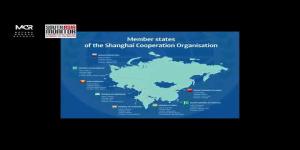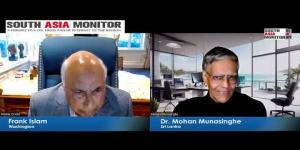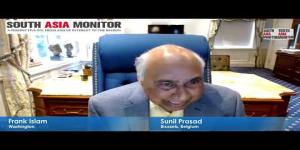A Reconfigured Geoeconomic Landscape Presents India With A Strategic Opportunity
India should reiterate its strategic autonomy publicly while making clear that it views strong ties with the US as vital. India insists its oil purchases from Russia are driven by economic necessity, not geopolitics, while questioning US-EU hypocrisy on Russia sanctions. Counter Trump's alignment with Pakistan and inflammatory rhetoric by highlighting India’s reliability as a global partner and democratic ally in the Indo‑Pacific.

It is now an accepted reality that the world is churning and we are facing turbulent, fairly violent times. The prediction that the world has entered a unipolar peaceful era with the downfall of the Soviet Union has been gradually but surely cast asunder. Probably, in the economic, geo-political worldly scheme of things this too is part of the adage ‘nothing is permanent in this world except change’.
However, when one examines the current times propelled by Trumpian tariffs and uncertainty, there seems to be continuity in the flux. In maritime parlance while the sea is choppy, there seems to be predictability in the choppiness; no sudden tsunamis or gale force winds, and even if geographically localised strong winds of violence suddenly pops up, it seems to be within the red lines of control. Take the Russia-Ukraine, Israel-Gaza-Iran-Hezbollah-Syria, India-Pakistan conflicts; sudden gusts but the wildfire was controlled and never looked like spreading uncontrollably. The actors were playing within their script for achieving national objectives but not overreaching; the main players (the major powers USA, China, EU) too ensured that the fires were contained.
Amidst this President Donald Trump appears to be playing wild cards trying to destabilise/fan the fires or so it seems to the less discerning eye. Is Trump actually outsmarting everyone by playing the oldest trick of all, “Divide and Rule”? of dealing bilaterally with all, not allowing his competitors/adversaries and even allies to get together and put up a unified resistance.
Trumps tactics now follow a choreographed pattern; cause chaos and paralysis by an initial alarming/unreasonable demand, followed by a backing down to what appears to be more reasonable levels which could well be his real objective in the first place. By dealing bilaterally and working on the weakness/vulnerabilities of the other nation, he appears to be winning. The jury is still out with numerous analysts predicting differently on whether at the macro-economic and even geopolitical stage USA will win or benefit from these manoeuvres; but apparently, he is getting his way despite the bluster and standoffs done by some bigger players more to please their domestic audience.
The president’s tactics seem to echo his “Art of the Deal” approach. Use economic leverage to essentially force trading partners to show him the money or face astronomical tariffs. To trade experts, the commitments raises the question of whether Trump is negotiating with trading partners or trade hostages. A couple of illustrations to prove the point.
To secure a lower tariff rate in its deal, South Korea agreed to make $350 billion in investments in the US and buy $100 billion of liquefied natural gas.
The E.U indicated that it would buy $750 billion of American energy and that its companies were poised to invest at least $600 billion.
Japan said it would establish a $550 billion fund for investments in the US.
India is holding out so far. The sudden imposition of 25% tariff has upended months of talks. The foreign ministry said Trump’s threat of additional tariffs was “unjustified and unreasonable” and vowed to “take all necessary measures” to safeguard India’s interests.
It is worth mentioning that focusing on the eye-popping investment figures might be premature. Tariffs are easier to enforce than investment and purchase commitments, and their vague nature suggests that countries might be looking for creative ways to escape Trump’s tariffs. Some of the pledges appear too big to be true, and many of them lack specifics.
Broad Geopolitical Shifts through the American Prism impacting India
The emergence of a new "Axis of Upheaval", China, Russia, Iran, North Korea, have strained global norms, encouraged fragmentation of global institutions and increasing conflict risks. India’s non-aligned, autonomous, principled stand on issues has not helped matters as it does not necessarily align with US perceptions.
The re-surgent strategic alignment between Trump and Pakistan which includes a new oil and trade deal has sharpened tensions with India. This and pressure on India to reduce its ties with Russia mark a fracturing of former personal diplomacy.
Will Tariffs make America Great Again (MAGA). Only time will tell, whether USA gains time and momentum to become MAGA, but it will only be a short breather; the decline is irreversible and statistically well founded. The shape of the world order is another matter; for a century we are used to a rarefied global power club ruling the world (uni/bipolar); will we actually see a multi-polar world and will it be more stable needs deeper analysis and study. Man is too greedy to share the benefits the world has to offer; and after all change is the only constant.
Impact on India
Trade and Economic Effects
Exports: The US is India’s top trading partner with roughly 17–18% of India’s total exports (~USD 87 billion/year) and significant in manufactured goods ranging from textiles, gems, auto components to pharmaceuticals. Tariff hikes of 25% could reduce demand for these exports significantly, especially in labour-intensive sectors.
Most Vulnerable Sectors: Textile and gems & jewellery are most vulnerable; pharma, auto components, electronics and petroleum products follow closely.
Likely impact on GDP: Estimates point to a reduction in FY2025‑26 growth by 0.2–0.5 percentage points (~6.2% instead of 6.5%), particularly from manufacturing slowdown and export margin compression.
Currency & Stock Markets: The rupee has slumped to record lows (~₹87.7/USD), equity indices are falling steadily amidst uncertain market sentiment, and foreign institutional investors have offloaded export-heavy stocks.
Sector-Level Risks & Opportunities
Textiles & Gems/Jewellery: Faces the most immediate hit. Analysts expect margin pressure and order cancellations, especially critical since Bangladesh and Vietnam now offer lower tariffs in the U.S.
Pharmaceuticals: US is the largest export destination (~USD 8 billion in formulations). Tariff increases may erode price competitiveness and amplify supply‑chain disruptions.
Automobiles & Auto-parts: While vehicle exports to the U.S. are relatively small, auto components exports (~USD 2.2 billion) could still benefit from US importers seeking suppliers outside China. The uniform tariff regime may actually level the playing field versus competitors.
Electronics / iPhones: India recently surpassed China as the top source of iPhones in the U.S., but full 25% tariffs could force Apple to re-evaluate the decision to produce outside the US.
IT Services: While services are largely tariff-exempt, economic slowdown and visa/tax policy friction
The Silver Lining
Exemptions from the tariffs are products from Annex 2 as mentioned on 02 Apr 25. Excerpts from White House statement “the additional 25% tariff imposed by this order shall not apply to articles set forth in Annex II to Executive Order 14257” This indicates that US is still not erecting import barriers on products which are critical and crucial for them like Pharma, Minerals etc. This clearly shows that US is playing safe with its own strategic interest. Some midway solution should emerge in one month.
Annexure 2 Exemptions
Mineral substances (e.g., magnesite, asbestos, fluorspar, cryolite)
Metallurgical products and ores (e.g., manganese, copper, cobalt, aluminum, zinc, tungsten, uranium, tantalum-niobium, antimony)
Fuels, coal, petroleum, and related products (e.g., anthracite, bituminous and other coal types, petroleum coke, bitumen, lubricating oils and greases, various fuel oils, natural gas, liquefied gases)
Industrial and specialty chemicals (e.g., iodine, rare gases, boron, silicon, rare earth metals, arsenic, lithium, magnesium, antimony oxides, titanium oxides)
Pharmaceutical precursors and intermediary chemicals
Other chemicals: including acids, esters, amides, phenols and derivatives, as well as specialty organic compounds used in chemicals and drug manufacturing
India’s Strategic Response: Actions Recommended
Diplomacy & Negotiations
Intensify negotiations on a bilateral trade agreement (BTA). US Vice President JD Vance’s recent visit to India aimed to pause tariff threats and advance terms around energy, defence, and technology cooperation to double trade to USD 500 bn by 2030.
Some experts suggest offering symbolic US wins, like lowering duties on US imports (LNG, whiskey, almonds, defence items) without undermining domestic political standing. However, some areas remain non-negotiable like agricultural liberalization being both politically sensitive and impacts the farmer, due to large rural populations and past protests
Economic Diversification
Accelerate export diversification into EU, UK, ASEAN, West Asia and Africa. Broaden the export basket to reduce dependence on U.S. markets and spread risk.
Expedite pending FTAs with UK, EU, Gulf nations and participation in trade frameworks like CPTPP or IPEF to open alternative markets and attract investments.
Manufacturing & Industrial Reform
Use this as a wake-up call for structural reforms: reduce import duties on key raw materials, simplify regulations, lower manufacturing cost burdens (e.g. electricity subsidies), streamline labour laws, and enhance logistics infrastructure.
Expand PLI (Production Linked Incentive) schemes in sectors such as textiles, electronics, and auto components to improve India’s competitiveness globally.
Safety Nets & Support for Sensitive Sectors
Offer targeted relief measures: export subsidies, tax refunds, working capital support for textile, pharmaceutical, and leather sectors. Government must act quickly to support MSME exporters facing order cancellations and margin pressure.
Strengthen foreign exchange stabilization tools and maintain RBI readiness for rupee volatility to prevent runaway depreciation and inflationary consequences.
Strategic Alignment & Optics
India should reiterate its strategic autonomy publicly while making clear that it views strong ties with the US as vital. India insists its oil purchases from Russia are driven by economic necessity, not geopolitics, while questioning US-EU hypocrisy on Russia sanctions.
Counter Trump's alignment with Pakistan and inflammatory rhetoric by highlighting India’s reliability as a global partner and democratic ally in the Indo‑Pacific.
India’s Strategic Response
Avoid retaliatory tit-for-tat broad tariffs which would harm overall trade relations.
Resist overt alignment behind US adversaries like Russia and Iran just to antagonize the US. Pragmatism should guide India’s choices.
Avoid complacency in claiming resilience; winning small symbolic concessions must be balanced by meaningful growth‑enhancing reforms.
Offensive Strategy: Turning Crisis into Opportunity
Expand market share in US sectors vacated by Chinese exporters due to tariffs, especially in garments, auto parts, electronics, furniture, home wares, toys, and chemicals. Rankings as low‑cost competitor place India in a strong position.
Use export facilitation programs and better trade infrastructure to onboard small exporters in tier‑2/3 cities facing global headwinds.
Deepen collaboration with US businesses in high‑value sectors: defence manufacturing, renewables, semiconductors, and aerospace.
Accelerate digital trade, services exports (IT, fintech, healthcare), which are largely tariff‑immune and continue to see strong demand in the US market.
Domestic Reforms: Long‑Term Resilience
Take cues from past reform waves (1991, 1998) and use this external challenge as impetus for internal economic liberalization; targeted deregulation, anti‑monopoly reform, labour law flexibility, and investment in skilling and infrastructure.
Strengthen own value‑chain competencies; reduce dependence on imported inputs and promote domestic innovation in critical sectors like pharma, EV, clean energy, and digital services.
India: The enigmatic underachiever
Population, size, demography and momentum propels us (we possess all the ingredients), but so many fault lines attrite. Will our current model of “strategic autonomy with principle of ‘engage with all’” allow us to navigate these uncertain, turbulent waters? However much one wishes for a miracle, given the international eco structure our time has still not come. What does stand out for India is that we need to be strong multi-domain, as we cannot afford to be weak. Our very strengths and size dictate it or else we will actually be run over to the ridicule of the world. We have to play the game deftly and surely, we can approach our destiny before we complete our century.
Pragmatism and Realpolitik
Ironically, it is the US consumer and nobody else who will bear the brunt of the tariffs. Things which were unviable to exports at 25% tariff will continue to remain unviable at any rate, whether it is 25%, 50% or any number above that. Trump’s statement clearly indicates that he is just posturing to arm-twist and carve best possible deal in the interest of US economy. Ultimately, he also knows that some midway solution has to be arrived so that interest of both the negotiating countries are taken care. There is also speculation that it is to coerce Russia to come to negotiation table in Ukraine War; since if both China and India stop purchasing energy from Russia, it will be hit very hard.
Pain and Opportunity
In essence, Trump’s tariff offensive presents both immediate economic pain and a strategic opportunity for India. The repercussion; lower export earnings, lower growth (down to ~6.2%), and capital outflows is real, but if India leverages this moment to reform, diversify, and deepen strategic partnerships, it can emerge stronger, more globally integrated and less dependent on any single economy.
India’s response must be multipronged: diplomacy, diversification, structural reform, targeted support, and strategic outreach. That is how India not only defends its growth trajectory but emerges as a rising global force in the re‑configured trade landscape.
(The writer, a strategic analyst, is an Indian Army veteran who was Director-General of Military Operations. Views expressed are personal. He can be contacted at perumo9@gmail.com)
A Contrarian Point, However, Most Countries Are Used To A Sort Of ‘Free Ride’ From The US, As Far As Their Exports Are Concerned.
Now That The Lollipop Has Been Snatched Away, The Babies Are Crying!😊
Things Have To Be Somewhat Equitable, Imports Of Corn And Soybeans Would Not Really Hurt Indian Farmers, They Could Be Procured At Preferential Rates And Corn Can Easily Be Used For Poultry And Cattle Feed, An Essential Requirement To Improve Our Milk Production. Soybeans Can Be Used For Cooking Oil And The Residue To Enhance Cattle Feed.
Russian Oil, Which Is Essential To Us, Would Not Then Draw So Much Trumpian Ire!!😊
The apt quote is "loudest in the room is the weakest of them all" and Trump is now showing his hand as weak.
Indian exports diversification away from USA will reduce its USD denominated trade. The Australia India trade after EXTA agreement signed in 2022 has more than doubled from ~$16bn to ~$49bn by end 2025. The more Trump derails US India trade agreements and threatens higher tariffs, the more he's aligning himself with the Failed Marshal of Pakistan, who only few days ago while on US soil in Florida, threatened to anhilate over half of humanity by using their nuclear weapons stockpiles! Given North Korea and China assistance to Pakistani nuclear weapons technology proliferation in the past, Trump will most likely burn his domestic voter base and international credibility with such Trumpistan dream tantrums with Pakistan!
US designation of BLA as terrorist organisation could be the fear of Mukti Bahini outcomes of 1971 and they don't want to be caught napping with potential support from Taliban and Iran to BLA as they both have land land borders with Baluchistan.
QUAD disruption will be minimal from Trump tariffs. In fact, this will fast track the new rules based world order to avoid any country weaponise trade to achieve hegemonic control by abusing their balance of trade powers.
The Trump onion is peeling itself layer by layer, and hopefully he doesn't end up tearful from such rash actions and rhetoric!👍🏽🙏🏽










Post a Comment